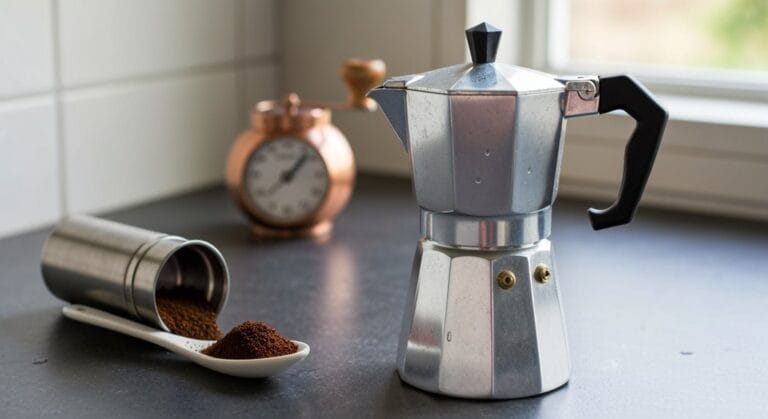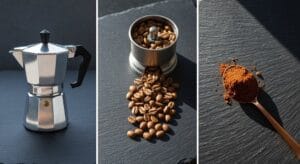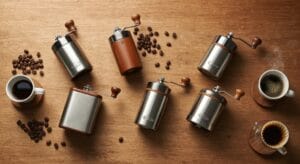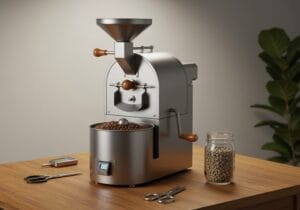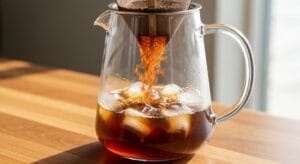You should aim for a sand‑like grind about 650 µm—fine enough to coax flavor but not so fine it clogs the pot, a fiasco! total chaos, mornings feel like traffic jams. A burr grinder beats a blade, delivering particles, and the setting shifts with roast: lighter beans a notch finer, darker a notch coarser, preventing bitter surprises. Grinding moments before brewing locks in aroma, while cleaning stops oil buildup. The rest of guide reveals more tricks.
Key Takeaways
- Aim for a medium‑fine grind (≈360‑660 µm, ideal ~650 µm) to balance extraction without clogging or under‑extracting.
- Use a burr grinder for uniform particle size; flat burrs give single‑modal flavor, conical burrs add body.
- Adjust grind finer for light roasts (360‑450 µm) and coarser for dark roasts (550‑660 µm) to prevent bitterness.
- Grind fresh immediately before brewing to preserve volatile oils and ensure vibrant flavor.
- Clean the grinder regularly (daily vacuum, bi‑weekly tablets, monthly deep clean) for consistent, waste‑free results.
Determine the Ideal Particle Size for Moka Extraction
When a home‑barista ultimately decides that the moka pot isn’t just a rusty relic but a gateway to espresso‑ish glory, the initial thing that trips them up is the grind—yes, that tiny mountain of coffee dust that looks suspiciously like table salt or, if they’re unlucky, powdered sugar that could double as face mask filler.
The sweet spot for particle size sits between 360 and 660 µm, roughly a medium‑fine texture, like sea‑salt, not flour. At about 650 µm with ~98 % uniformity, water slides through at 1‑2 bar, giving solid extraction efficiency without bitterness. Using a burr grinder ensures the consistent medium‑fine size needed for optimal extraction.
Too fine clogs the filter, slows flow, over‑extracts; too coarse makes it watery, under‑extracts. Think of it as tuning a tiny pressure cooker, and your taste buds will thank you every single morning.
Use a Burr Grinder for Uniform Consistency
Because a blade grinder chops beans like a lawn‑mower on a sugar‑cane field, the resulting coffee looks more like confetti than the sea‑salt grit a moka pot craves.
Anyone who’s ever tried to sip that murky brew knows the frustration is real—like watching a sitcom where the punchline never lands.
Switching to a burr grinder instantly upgrades the game, because two burrs—flat or conical—crush beans into a predictable, sea‑salt texture instead of random confetti. The gap yields uniform grind shapes, so water flows evenly, avoiding bitter over‑extraction.
Flat burrs give a single‑modal distribution for clear flavor; conical ones add body with a bimodal spread. Furthermore, using a burr grinder supports consistent grind shapes that enhance the extraction process, crucial for achieving the ideal brew.
Grinder types aside, the consistency cuts waste, repeats results, and anyone can brag about a balanced moka pot cup.
Adjust Grind Settings Based on Roast Level
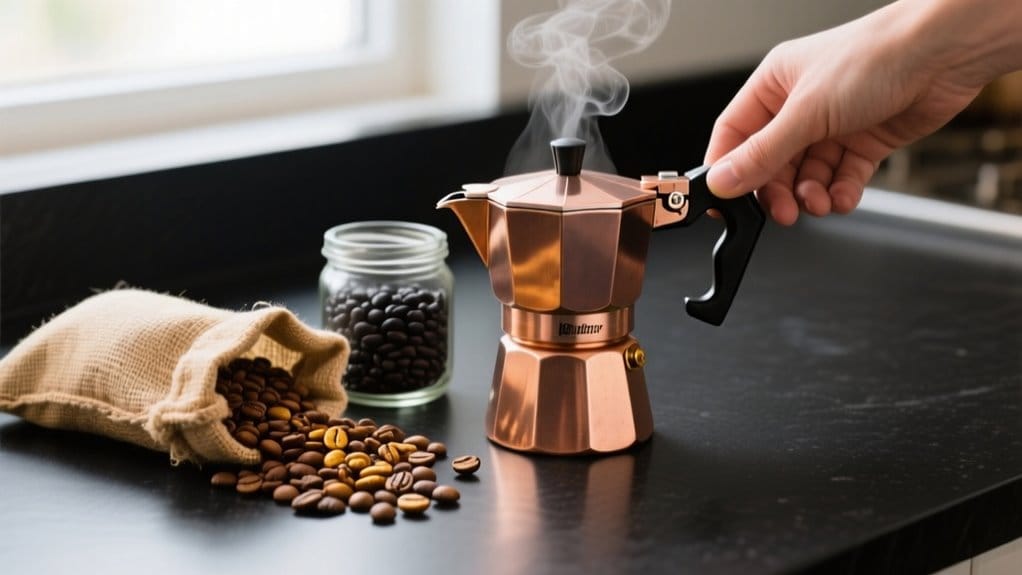
If the coffee enthusiast wants the moka pot to sing, they must consider that not all roasts are created equal, and tweaking the grind is the backstage pass that keeps the show from turning into a bitter disaster!
Light‑roast beans, dense and acidic, need a finer grind (around 360‑450 µm) – think table‑salt‑fine, otherwise the flavor stays hiding.
> Light‑roast beans demand a fine, table‑salt grind (360‑450 µm) or else their bright flavor stays hidden.
Medium roasts sit in the middle, 450‑550 µm, a happy medium that balances brightness and body.
Dark roasts, porous and bold, love a coarser setting (550‑660 µm) to avoid a choke‑up and bitter punch.
A grind adjustment—one notch finer for light, one coarser for dark—matches the roast profile, prevents over‑extraction, and keeps the pot from sputtering like a trumpet.
Everyone’s surprised when that initial sip suddenly smiles!
Grind Fresh Immediately Before Brewing
Although the moka pot only needs about five minutes to extract its brew, the moment the beans meet the grinder decides whether the cup will sing or sputter like a broken kazoo. Most baristas grind before the pot fires, because oxygen and moisture attack the grounds as they’re crushed, stealing flavor like a kid.
The freshness impact shows acidity and notes, while stale powder tastes flat, bitter, sour. Using a burr grinder set to texture releases volatile oils, enhancing coffee aroma that could rouse a bear. Freshly ground coffee retains optimal flavor due to higher elevation impacts, allowing for a more vibrant cup. In fact, caffeine content tends to vary based on the specific coffee type and brewing method, influencing the overall experience.
They dose, dump grounds into filter, close lid, and grin at ground packets that sit like forgotten socks. This grind‑to‑brew routine keeps extraction steady and cup singing, not squeaking.
Even dog sniffs the difference, wagging approvingly each morning.
Clean and Maintain Your Grinder for Consistent Results
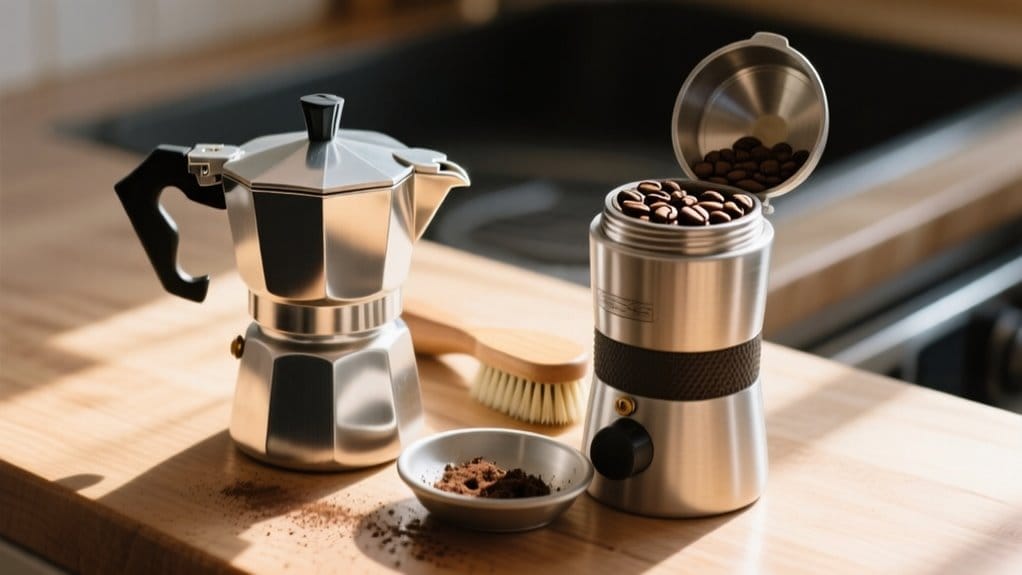
Cleaning the grinder every two weeks feels like a dental check‑up for a caffeine‑addicted mouth, but the payoff is a brew that doesn’t taste like old engine oil.
That realization usually hits the coffee nerd right after a disastrous espresso that screams “burnt rubber!” – a clear sign that oil and stale dust have taken over the burrs.
Follows a strict cleaning schedule: vacuum the chamber daily for dark roasts, run Urnex Grindz tablets bi‑weekly, and disassemble the hopper monthly with mild soap.
A quick brush before each run clears stuck particles, while a deeper two‑month burr purge with rice keeps the grind consistent.
Proper grinder maintenance extends lifespan, prevents bitter surprises, and guarantees every moka pot shot tastes bright, not burnt.
Frequently Asked Questions
How Often Should I Replace the Moka Pot’s Gasket?
The gasket should be replaced every three to twelve months, depending on usage; regular gasket maintenance prevents leakage, preserves brewing efficiency, and guarantees consistent pressure and flavor extraction throughout each brew cycle for superior performance.
Can I Brew With a Moka Pot on an Electric Kettle?
One cannot brew a Moka pot directly on an electric kettle; Moka pot compatibility requires a stove or heat source, while electric kettle brewing merely preheats water before the pot receives external heat properly safely.
What Water Temperature Is Ideal for Moka Pot Extraction?
Like a sunrise gently heating the horizon, the ideal water temperature for moka pot extraction is about 93 °C (200 °F). Proper brewing techniques and water quality further guarantee balanced flavor without bitterness in every cup.
How Does High Altitude Affect Moka Pot Brewing Pressure?
At high altitude, reduced atmospheric pressure causes lower boiling temperatures, leading to pressure variations inside the moka pot; consequently, brewing adjustments such as finer grind and hotter water are required to maintain extraction for consistent results.
Is Pre‑Heating Water Before Adding It to the Moka Pot Recommended?
Like a sunrise coaxing shadows, the brewer finds pre‑heating water recommended; pre heating benefits include consistent temperature, boosted extraction, and improved water quality, ensuring balanced flavor without over‑extraction or bitterness in every morning brew routine.

